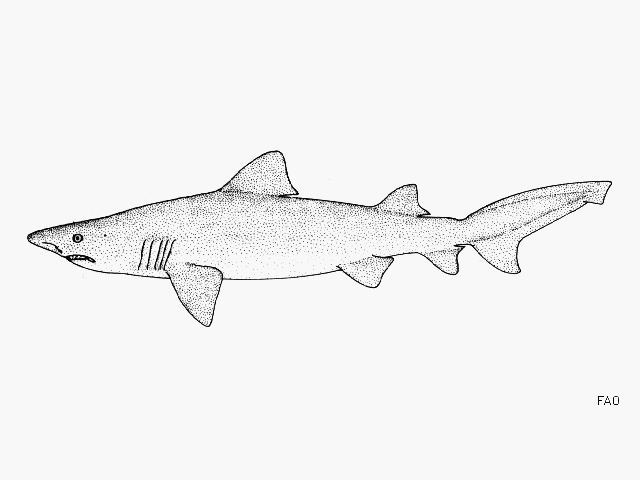| Odontaspididae (Sand tiger sharks) |
| 450 cm TL (male/unsexed); max.weight: 289 kg |
|
benthopelagic; marine; depth range 10 - 2000 m |
| Eastern Atlantic: Gulf of Gascony, Madeira, Morocco, Mediterranean; also Cape Verde (Ref. 27000). Western Atlantic: Yucatan Shelf, Mexico (Ref. 9939), Brazil (Ref. 53443). Indo-West Pacific: off South Africa and Maldives, Madagascar, southern Japan, Australia, and New Zealand (Ref. 13568). Expected to occur in the Western Central Pacific (Ref. 13568). Central Pacific: off Hawaii (Ref. 13568). Eastern Pacific: off southern California, USA and Baja California, Mexico (Ref. 13568). |
|
Dorsal spines (total): 0-0; Dorsal soft rays (total): 0-0; Anal spines: 0-0; Anal soft rays: 0-0. A shark with a short, pointed snout, small eyes, protruding spike-like teeth, and small, equal-sized dorsal and anal fins; first dorsal closer to pectoral than to pelvic fins (Ref. 5578). Grey above, paler below (Ref. 6586); may have red spots on sides (Ref. 5578). |
| Found on or near the bottom of the continental and insular shelves and upper slopes (Ref. 6871); sometimes in shallow water (Ref. 6871). Tagging showed the species dives up to 2,000 m at Malpelo Island, Colombia (S.Bessudo, pers.comm. 06/09). Feeds on small bony fishes, squids, and crustaceans (Ref. 13568). Uses its long body cavity and large, oily liver to regulate buoyancy. Ovoviviparous, embryos feeding on yolk sac and other ova produced by the mother (Ref. 50449). Not implicated in attacks on people (Ref. 247). Flesh utilized for human consumption and liver for its high squalene content (Ref. 247); utilization of fins, jaws and cartilage (Ref.58048). |
|
Endangered (EN); Date assessed: 01 June 2023 (A2d) Ref. (130435)
|
| harmless |
Source and more info: www.fishbase.org. For personal, classroom, and other internal use only. Not for publication.
